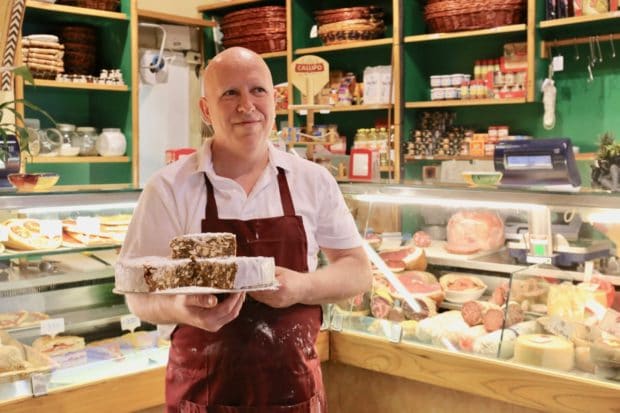Planning a vacation to Italy but find yourself short on time so looking to visit Florence in a day?
We’ve created the perfect Florence self guided walking tour that minimizes your travel on foot. Visit the majority Florence’s best attractions in just 24 hours!
Florence in a Day
The capital of Tuscany is one of the world’s most romantic cities, where jaw-dropping Renaissance art mingles with a contemporary cosmopolitan sensibility.
Florence is considered the cradle of the Italian Renaissance, the birthplace of a cultural and artistic revolution which launched in the 15th-century. We have to thank the lavish patronage of the ruling Medici family, the richest family in Europe at the time. The Medici commissioned works by artists and architects like Michelangelo, Botticelli, Donatello, Brunelleschi and Leon Battista Alberti, crafting a city that sets hearts aflutter to this day.
In an ideal world we’d suggest spending a minimum of three days to explore Florence. While you’ll still feel a bit rushed, three days in Florence allows you to explore inside all of the city’s cathedrals and museums, home to some of the world’s best Italian Renaissance artwork. If time is really on your side add as many days as you can (a week would be so dreamy) so you’re not rushing to see all of Florence’s iconic attractions.
But we’re guessing your time is tight. Are you a first time visitor curious about what you can realistically see in Florence in a day? Don’t fret, it’s entirely possible to enjoy a self-guided walking tour in just 24 hours!
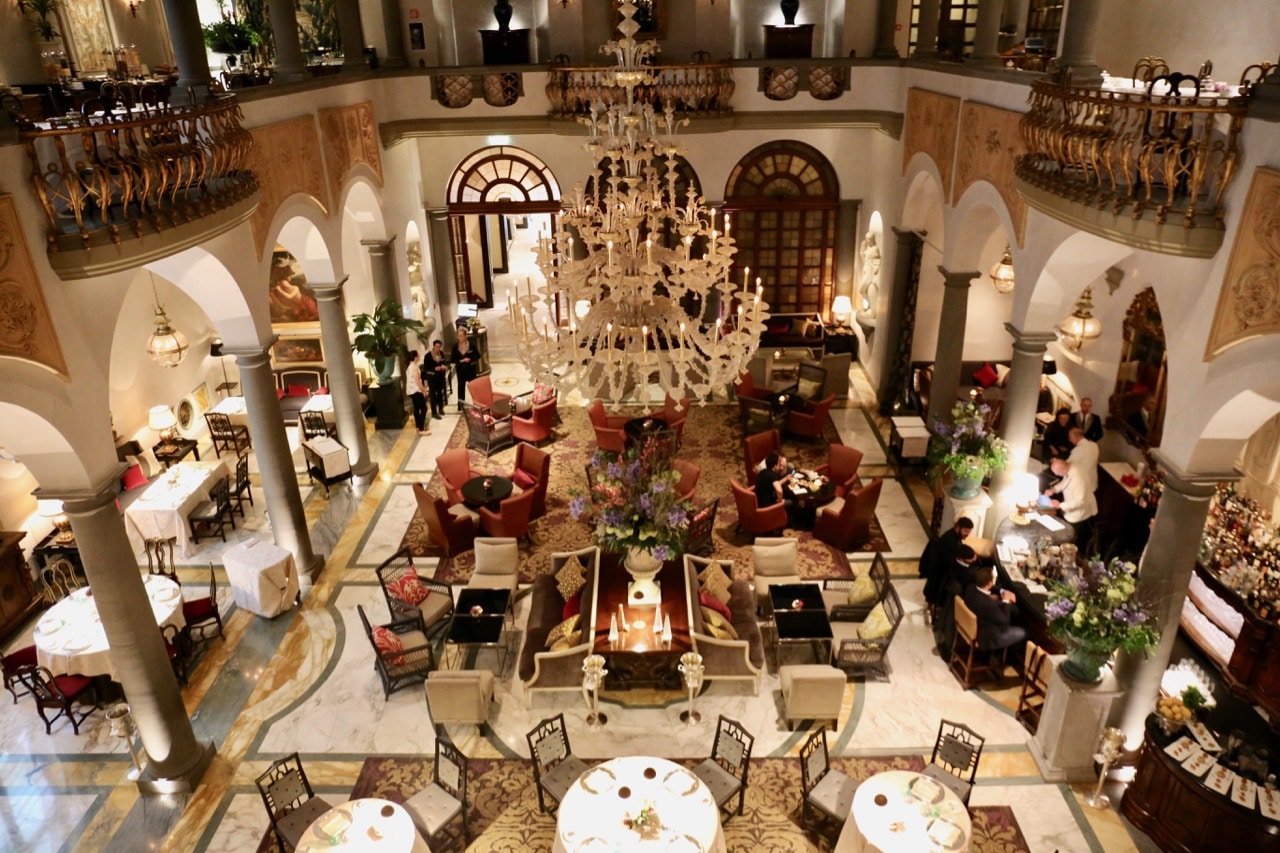
Planning a Florence in a Day Itinerary
If you’re researching how to plan a Florence in a day itinerary it’s best to ensure you’re not biting off more than you can chew. To properly enjoy your short 24 hours in Florence, ensure you’re setting reasonable expectations on what you can see and do in one day.
Our Florence in a day itinerary starts at the St Regis Hotel, a perfect place to splurge on a sweet suite if you’re only in town for one night. The luxury hotel is perfectly situated in the heart of Florence, walking distance to all of the city’s top attractions. If you’re arriving in the morning at the Florence Train Station, the St Regis Hotel is a short 5 minute walk towards the Arno River.
Our Florence in a day walking tour includes the number of minutes it will take you to travel between each attraction. You can easily walk to all of these attractions in one day if you follow our route.
Please take note: we have not accounted for the time required to enter and explore these attractions. We suggest finding one or two attractions you really have your heart set on and focusing a quick tour of the interiors highlights before moving on to the next item on the itinerary.
If you’re visiting Florence in a day, you’ll likely save a lot of money, as appreciating the ornate exteriors of each of the city’s architectural gems is free! If you are planning on taking the time to visit the Uffizi Gallery and Florence Cathedral, avoid wasting time waiting in line by making reservations in advance.

Start Your Florence in a Day Itinerary at The St Regis Hotel
Piazza Ognissanti, 39-055-27161
The St. Regis Hotel Florence is considered to be one of the city’s most luxurious hotels. If you have to see Florence in a day, we suggest booking your one romantic night here.
The posh property is located on the north bank of the Arno River. Sitting perched over Piazza Ognissanti, St. Regis Florence is a short 10-minute walk from Ponte Vecchio.
In 2011 the hotel unveiled a $25 million top-to-bottom renovation of a Renaissance pallazo (formerly the Grand Hotel) designed by Filippo Brunelleschi. Skip inside and you’ll find marble hallways, coffered frescoed ceilings, a harmony of antique and custom furnishings, gorgeous gilt mirrors and sparkling Murano glass chandeliers.
Book yourself a Prelium Deluxe Arno Room and you’ll have access to your own butler who unpacks your bags, does your ironing and brings complimentary tea and coffee to your bed each morning.
Chef Valeria Piccini’s creative local take on Tuscan cuisine is served in the upscale Winter Garden by Caino restaurant. The celebrated dining room has earned a Michelin star, drawing foodie fans from around the globe who eat here under a gorgeous stained-glass ceiling.
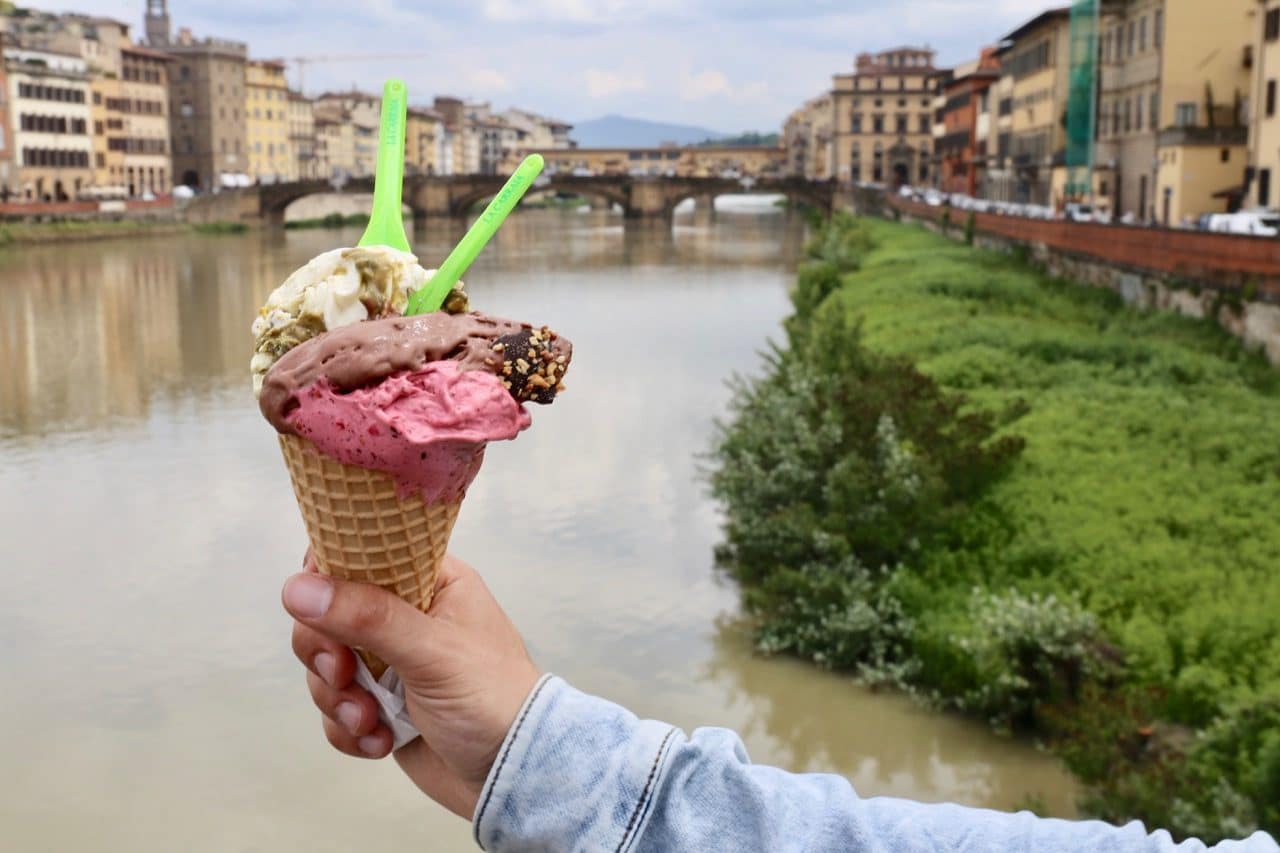
Gelateria La Carraia
Piazza Nazairo Sauro, 39-055-280695
A 6 minute walk from St Regis Hotel Florence.
The streets of Florence are packed full of gelato shops. No trip to Tuscany is complete without a daily dose of Italy’s artisanal ice cream. You’ll find tourists clutching waffle cones everywhere, eagerly licking up sweet dairy drips as they gawk at the city’s awesome architecture.
If you’re planning to visit Florence in a day, it’s best to ensure you’re stopping for a gelato break at the best gelateria in town. The most popular gelato shops are the ones that make their ice cream in-house. They use fresh, natural ingredients, many of which are unique to the season and region.
Never ordered gelato in Italy before? First choose if you want a cup or cone. Then take a look at the flavours and decide which ones appeal to you most. A small generally includes two flavours, medium and large are three flavours and an extra large includes four scoops (and a bulge to your waistline)!
Once you’ve made your decision walk over to the register and pay before ordering. With your receipt in hand place your order with the attendant scooping the gelato into each cone and cup.
Regularly ranked as the best gelato in Florence, Gelateria La Carraia is located a short walk from the St Regis Hotel at Ponte alla Carraia. La Carraia has been serving gelato in Florence since 1990 and is known by locals for its creamy and soft texture. Their most popular gelato flavours include almond milk, ricotta cheese and pear, and yogurt nuttella.
In 2008 La Carraia had experienced such success that they opened a second location on Via dei Benci near Piazza Santa Croce, but the selection is more limited.
You May Also Enjoy Reading…
- Pisa Attractions: Explore Beyond The Leaning Tower
- Luxury Living at Grand Hotel Continental Siena
- Things To Do in Siena: A Comprehensive Guide
- Castello di Velona: Tuscany’s Best Luxury Spa Getaway
- Sorano Italy: An Ancient Medieval Hill Town in Tuscany

Pitti Palace
An 8 minute walk from Gelateria La Carraia.
Located just south of the Arno River and Ponte Vecchio, Pitti Palace is a vast Renaissance palazzo and garden. The majority of the palace today dates from 1458 and was the originally the residence of Luca Pitti, a successful Florentine banker.
In 1549 the Medici family bought Pitti Palace, quickly becoming the residence of the ruling families of the Grand Duchy of Tuscany. It became known as a treasure trove, housing a vast collection of paintings, plates, jewelry and luxurious furniture.
In the 18th-century it was used by Napoleon and later served as the royal palace of the newly united Italy. In 1919, King Victor Emmanuel III donated the palace and its contents to the Italian people.
Today, Pitti Palace is the largest museum complex in Florence. It houses important collections of sculptures, paintings, art objects, costumes and porcelain. The collection at Pitti Palace is separated into five museums: Paltine Gallery, Modern Art Gallery, Costume Gallery, Silver Museum and Porcelain Museum.
Behind the Pitti Palace are the Boboli Gardens, sprawling across an area of 45,000 square meters. It’s the largest green space in Florence, featuring grottos, fountains, pergolas, a small lake and hundreds of statues.

Ponte Vecchio
A 4 minute walk from Pitti Palace.
The Ponte Vecchio is a medieval stone arch bridge that straddles the Arno River. It is one of the most photographed landmarks in Florence, appearing on hundreds of postcards as an emblem of the city. No visit to Florence is complete until you’ve skipped across this romantic bridge.
Ponte Vecchio is famous for having shops built along each side of the bridge. Historically butchers occupied the shops here, but today you’ll mostly find luxury jewellers, art dealers and souvenir shops. The romantic bridge honours its glamorous golden history by featuring a bust of Benvenuto Cellini, a notable 16th-century goldsmith.
It is believed that a bridge was first built here in Roman times as it straddles the Arno River at its narrowest point. Ponte Vecchio first appears in local history books in 996. The bridge has been destroyed by floods and rebuilt several times over the years.
The current bridge was built in 1345, but historians aren’t certain who built it. While Giorgio Vasari attributed the bridge to Taddeo Gaddi, art historians seem to believe the construction is more likely by Dominican friars.
In order to connect Palazzo Vecchio with Palazzo Pitti, Cosimo de’ Medici in 1565 had Giorgio Vasari build the Vasari Corridor above. Today, in its Uffizi section, the Vasari Corridor is used to exhibit the museum’s collection of self-portraits.
Ponte Vecchio is uniquely the only bridge in Florence that was not destroyed during World War II. During the Nazi retreat in 1944, all of the Florentine bridges were bombed, except one. Gerhard Wolf, the German consul in Florence at the time, has been credited for saving the city’s beloved bridge. As a sign of gratitude, he was made an honorary citizen of Florence in 1955. A marble plaque in his honour was unveiled on Ponte Vecchio in 2007.
The best way to enjoy Ponte Vecchio is by booking a boat trip on the Arno River. You can enjoy a unique view of the bridge from inside a small vintage boat, recently restored by the Renaioli.
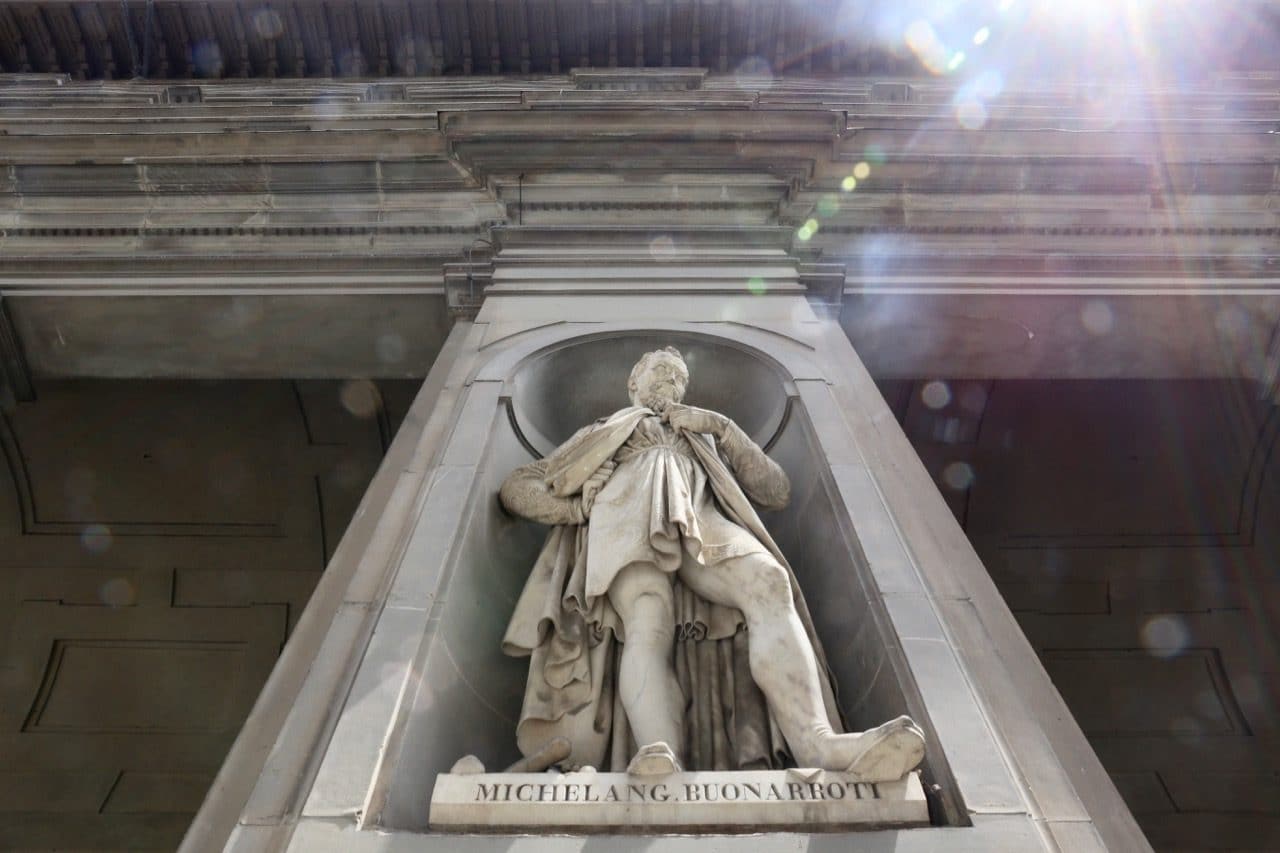
Uffizi Gallery
Piazzale degli Uffizi, 39-055-294883
A 2 minute walk from Ponte Vecchio.
The Uffizi Gallery is regularly ranked as one of the best art galleries in the world. You could easily spend an entire day skipping through the museums art adorned hallways. If you’re seeing Florence in a day and only have time to buy a ticket to one attraction we’d suggest the Uffizi Gallery. It offers the best bang for your buck!
Located between Ponte Vecchio and Palazzo Vecchio, the Uffizi Gallery offers one of the world’s best collections of Renaissance art. After the ruling Medici died out, their art collections were gifted to the city of Florence, making it one of the first modern museums. The gallery had been open to visitors by request since the 16th-century, but in 1765 it officially opened to the public.
Doing your art history homework in advance means you can focus on seeing the most important paintings and sculptures without taking up too much time. Must-see artworks at the Uffizi Gallery include:
- The Birth of Venus and Primavera by Botticelli
- Doni Tondo by Michelangelo
- Venus of Urbino by Titian
- Annunciation and Adoration of the Magi by Leonardo da Vinci
- Madonna of the Goldfinch by Raphael
- Ognissanti Madonna by Giotto
- Madonna with the Long Neck by Parmigianino
- Portinari Altarpiece by Hugo van der Goes
- Sacrifice of Isaac and Medusa by Caravaggio
- Coronation of the Virgin by Fra Angelico
Pushing through crowds in a busy art gallery isn’t your thing? We suggest at the very least enjoying a quick stroll in front of the Uffizi Gallery to spot the statues of Florence’s most famous Renaissance artists. Point your phone towards the sky and you can snap a selfie with sculptures of Michelangelo, Leonardo da Vinci and Raphael.

Loggia dei Lanzi
A 1 minute walk from the Uffizi Gallery.
Loggia dei Lanzi is a building on the corner of the Piazza della Signoria, located beside Palazzo Vecchio and the Uffizi Gallery. Since the building plays neighbour to two of Florence’s most visited attractions, it’s always bustling with tourists. Clutch your camera and point your elbows out!
Loggia dei Lanzi was built between 1376 and 1382 by Benci di Cione and Simone di Francesco Talenti. After the construction of the nearby Uffizi, the Loggia’s roof was modified to become a terrace where the Medici elite could watch ceremonies in the piazza.
Loggia dei Lanzi consists of wide arches that open into the street that rest on a cluster of pillars with Corinthian capitals. The breezy archways were so appealing to locals that Michelangelo suggested they be continued around the Piazza della Signoria.
Today, Loggia dei Lanzi effectively acts as a free open-air sculpture gallery of antique and Renaissance art. The entrance steps are flanked by two marble Medici lions, classic symbols of Florence.
Stroll around the interior and you’ll find some of the Italian Renaissance’s most famous sculptures. Highlights include Perseus with the Head of Medusa, The Rape of the Sabine Women and Hercules beating the Centaur Nessus.
From the Loggia dei Lanzi’s elevated platform, you can get the best photographs of a replica of Michelangelo’s world-renowned masterpiece. With only 24 hours in Florence you’ll likely have no time to visit the Galleria dell’Accademia, where the original statue of The David stands. The next best thing is eyeing the sculpture for free as it stands today at the entrance of Palazzo Vecchio.
You May Also Enjoy Reading…
- Pitigliano Italy: Explore Tuscany’s Ancient Jewish History
- Saturnia Hot Springs: Wellness Spa Holiday in Tuscany
- Agriturismo Volterra: Book the Best Farmstay in Tuscany
- Travel to Florence, Italy
- Tuscan Honeymoon: Best Romantic Holiday in Italy
- Tuscan Food: 20 Must-Try Dishes and Drinks
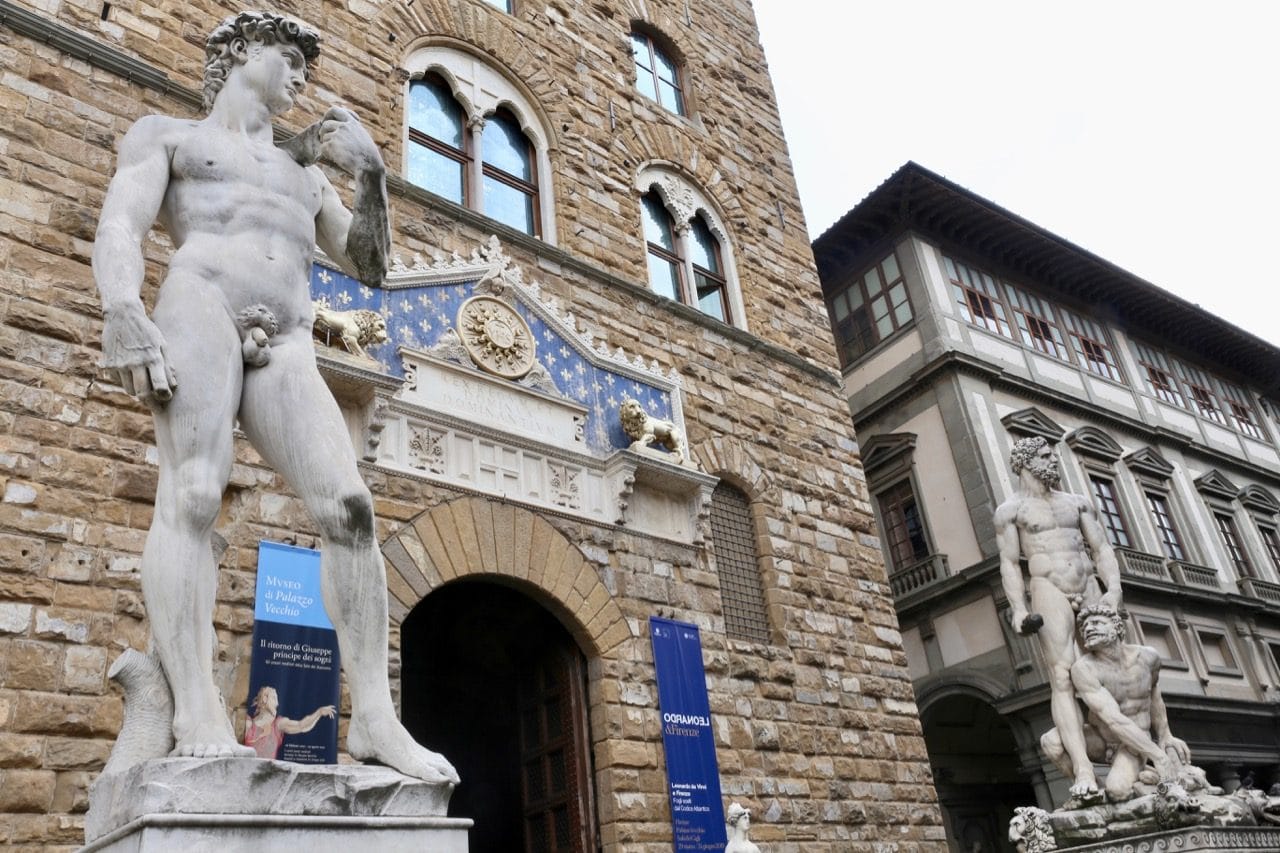
Palazzo Vecchio
A 1 minute walk from Loggia dei Lanzi.
Palazzo Vecchio is located directly beside the Uffizi Gallery and Loggia dei Lanzi in Piazza della Signoria. A visit to Palazzo Vecchio offers Roman ruins, a Medieval fortress and amazing Renaissance sculptures, paintings and frescoes.
Long considered the symbol of civil power in Florence, construction on Palazzo Vecchio first began in 1299 above the ruins of the Uberti Ghibelline towers. The entire fortress rests on top of an ancient Roman theatre, whose archaeological ruins can be seen in the underground level.
Built in 1494, The Hall of the Five Hundred is the largest and most significant room inside Palazzo Vecchio. The jaw-dropping space measures 54 metres in length, 23 metres wide and 18 metres high. The impressive interior features ornately decorated ceilings, large wall frescoes, glowing golden decorations and a parade of sculptures.
Palazzo Vecchio’s current appearance can be attributed to renovations made around 1540, when Duke Cosimo I de’ Medici decided to turn the palace into their official residence. Today, visitors enjoy tip toeing through a dazzling labyrinth of chambers, apartments, terraces and courtyards. The rooms inside Florence’s palace are gorgeously decorated by Italian Renaissance masters such as Michelangelo, Giorgio Vasari and Donatello.
On the second floor the most interesting room is the Hall of Maps, featuring the Mappa Mundi, a six-foot-tall sphere which was the largest rotating globe of its time. Take your time to explore the interior and you’ll find dozens of geographic maps painted on leather. They offer insight into how the world was understood in 1563.

Piazza della Repubblica
A 4 minute walk from Palazzo Vecchio.
Enjoy a short walk north from the hustle and bustle of Piazza della Signoria and you’ll arrive at Piazza della Repubblica. It’s one of the main squares in Florence, marking the centre of the city since Roman times.
The Column of Abundance marks the point where the cardus and decumanus maximi met and where the Roman forum once stood. The current column which stands in the square today was erected in 1431.
During medieval times the area around the column was packed with markets, tabernacles and churches. It was also the location of the Jewish ghetto, as jews were obligated to live here by Cosimo I. Historians say the column once had a bell, which would be rung whenever pick pockets were found roaming the square. A helpful warning for local shoppers!
The square today offers a stage for street artists and impromptu art shows, best enjoyed after sunset. Piazza della Repubblica is also home to the historical Caffé Gilli, Caffé Paskowski and Caffé delle Giubbe Rosse, social hubs for many of Florence’s artists and writers during the turn of the 20th-century.
The most prominent structure on the square today is its triumphal arch, know by locals as the Arcone. But perhaps Piazza della Republicca’s biggest draw is its vintage carousel featuring 20 horses and two gilded king’s carriages. Florence’s famous merry-go-round was originally owned by the Picci family. Today, it offers giggles of glee to children and families who spin around in the centre of the square from 10am to 8pm.

Caffe Gilli
Via Roma, 39-055-213896
A 1 minute walk from Piazza della Repubblica.
Located a short stroll from Piazza della Republicca, Caffe Gilli is the perfect spot to enjoy a quick mid-afternoon sip and nibble.
Caffee Gilli proudly holds the title of oldest cafe in Florence, first opening its doors in 1733. Florence’s historic cafe was originally established by a Swiss family during the Medici era. Today, it’s the only example of a Florentine Liberty-style cafe left in the city.
The best cafe in Florence originally started as a bozzolari, a shop that made sweet doughnuts. Skip inside the cafe today and you’ll find a dizzying number of pastries, bonbons, jellies and chocolates. We spotted Sicilian cannolis, bright berry tarts, and cream-filled profiteroles drizzled with smooth dark chocolate ganache.
Caffe Gilli’s shop windows are perhaps the most famous in Florence. During holidays such as Christmas and Easter, the shops window’s can be found richly decorated with decadent festive delights.
The cafe is popular with locals who come here to sip froth cappuccino and tiny espresso while standing up at the marble bar. And there’s a reason you’ll find locals standing and tourists loitering in the luxurious dining room.
You’ll pay three times as much to enjoy a drink while sitting down rather than at the bar. A cappuccino costs €1.40 standing up and €5.50 when served at a table.

Florence Baptistery
A 2 minute walk from Caffe Gilli.
The Florence Baptistery, also known as the Baptistery of Saint John, is one of the most famous religious buildings in Italy. The octagonal baptistery stands in both the Piazza del Duomo and the Piazza San Giovanni, directly in front of the Florence Cathedral.
The Florence Baptistery is one of the oldest buildings in the city, built between 1059 and 1128 in the local Florentine Romanesque style. While its origins are unknown, art historians believe it was built over the ruins of a Roman temple dedicated to Mars. The building was first documented in local history books in 897 as a minor basilica, while in 1128 it was officially consecrated as the Baptistery of Florence.
The Baptistery is world-renowned for its three sets of bronze doors with relief sculptures. In 1401, a competition was announced by the Cloth Importers Guild to design doors that would eventually be placed on the norther exposure. Many of Tuscany’s finest artists competed for the commission and a jury selected seven semi-finalists including Lorenzo Ghiberti, Filippo Brunelleschi, Donatello and Jacopo della Quercia. Astonishingly, 21-year-old Ghiberti won the competition and ended up finishing the famous bronze doors twenty one years later.
Italian Renaissance master Michelangelo famously dubbed the east set of doors on the baptistery as the Gates of Paradise. Each of the Florence Baptistery doors are made up of 28 quatrefoil panels, with the top twenty depicting scenes from the life of John the Baptist. The eight lower panels depict the eight great virtues of hope: faith, charity, humility, fortitude, temperance, justice and prudence.
Many notable Italian Renaissance personalities were baptized here, including poet Dante Alighieri and members of the Medici family.
Visit the Florence Baptistery in the middle of the day and you’ll likely encounter a mob of tourists gawking at the decorative doors. We suggest being patient so you can squeeze yourself to the front of the gate and take a few moments to enjoy the awesome artwork. If you’re a morning person, visit at dawn and you can enjoy the gates to yourself in sublime silence.
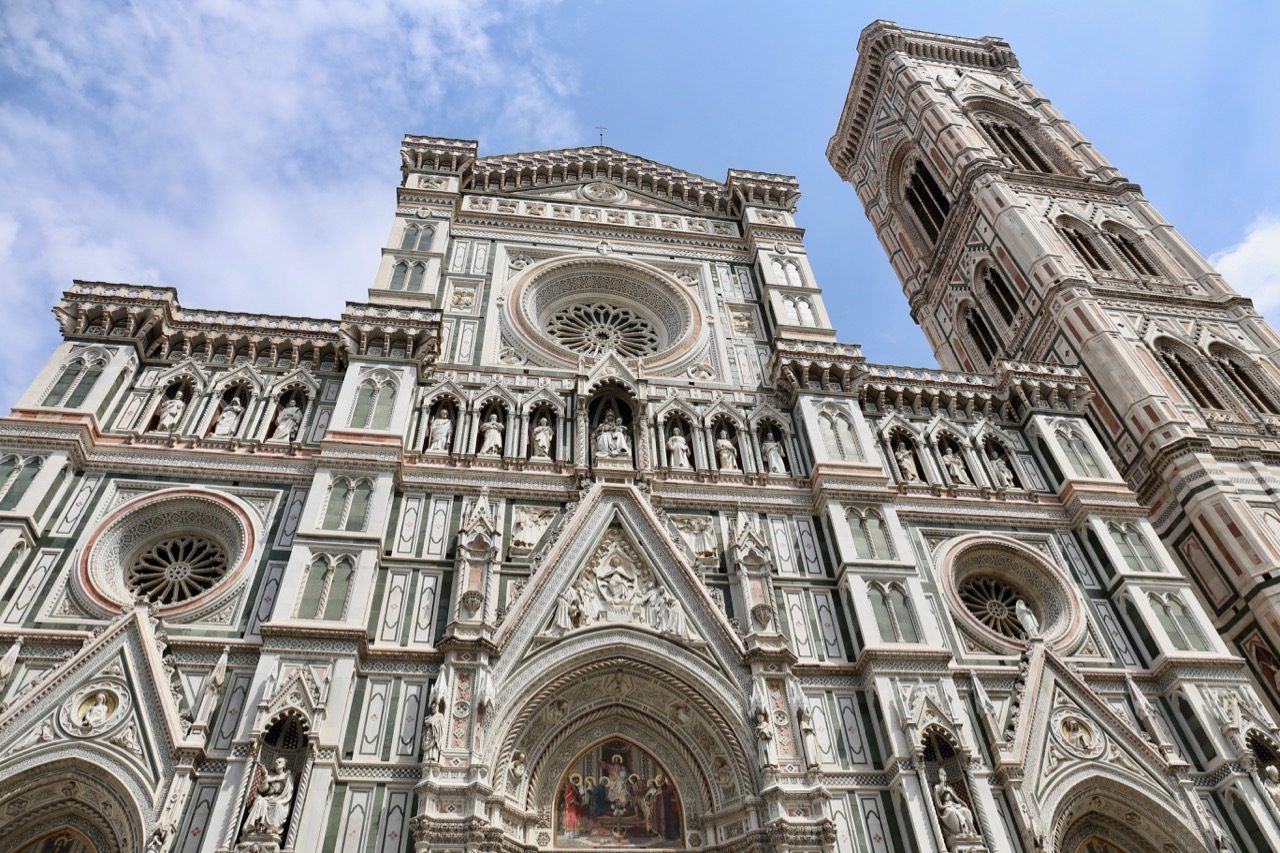
Florence Cathedral
Piazza del Duomo, 39-055-230-2885
A 1 minute walk from Florence Baptistery.
Florence Cathedral, also known as Cattedrale di Santa Maria del Fiore, is one of Europe’s most famous churches. The construction of Florence’s jaw-dropping cathedral began in 1296 in the Gothic style thanks to a design by Arnolofo di Cambio. It officially completed in 1436 with a spectacular dome designed by Filippo Brunelleschi.
The exterior of the Florence Cathedral looks a bit like a candy cane. The impressive facade is made up of polychrome marble panels in various shades of green, pink and white. A statue of architects Cambio and Brunelleschi can be found outside to the right of the cathedral. It appears as both stone statues allow the Renaissance masters to admire their work for the rest of eternity.
A visit to the basilica is one of the best things to do in Florence. It’s the third largest cathedral in the world and remains to this day the largest brick dome every constructed.
Step inside and you’ll find a Gothic interior that feels both vast and empty at the same time. The spiritual space’s bareness corresponds with the austerity of religious life. Must-see artistic works inside the Florence Cathedral include:
- Bronze shrine of Saint Zenobius by Lorenzo Ghiberti
- Dante Before the City of Florence by Domenico di Michelino
- Funerary Monument to Sir John Hawkwood by Paolo Uccello
- Equestrian Statue of Niccolo da Tolentino by Andrea del Castagno
- Christ Crowning Mary as Queen, a stained glass circular window by Gaddo Gaddi
- Cornoation of the virgin, a stained glass window by Donatello
- Funeral Monument of Antonio d’Orso by Tino da Camaino
- Monumental Crucifix behind the Bishop’s Chari by Benedetto da Maiano
- The Last Judgement painted dome by Giorgio Vasari and Federico Zuccari

Arno River at Sunset
A 9 minute walk from Florence Cathedral.
If the weather is clear, there’s no better way to wrap up your Florence in a day itinerary then by enjoying a romantic pre-dinner stroll at sunset on the Arno River.
We suggest checking your weather app to determine what time the sun is scheduled to set during your visit. Walk to the Arno River 30 minutes before sunset and you’ll join a throng of tourists looking to snap a postcard-perfect selfie of the city.
Many first time visitors make the mistake of gathering on Florence’s famous Ponte Vecchio at sunset. Since the bridge is flanked by shops, there are very few vantage points to photograph the sunset properly. In fact, the best photos of Florence at sunset are taken along the banks of the Arno River near Ponte Santa Trinita.
The bridge is located directly beside Ponte Vecchio and allows you to photograph the beautiful red, pink, orange, and yellow hues that splash across the river at dusk. After enjoying a romantic sunset photoshoot at Ponte Santa Trinita, grab a seat on one of the many patios that spill out onto the street.
Join locals in the daily celebration of aperitivo hour. Sip on Italian cocktails such as Aperol Spritz and Negroni while nibbling on complimentary potato chips, olives and peanuts. There’s no better way to celebrate your self guided walking tour of Florence in a day then by enjoying a pre-dinner cheers on a patio overlooking the Arno River at sunset!
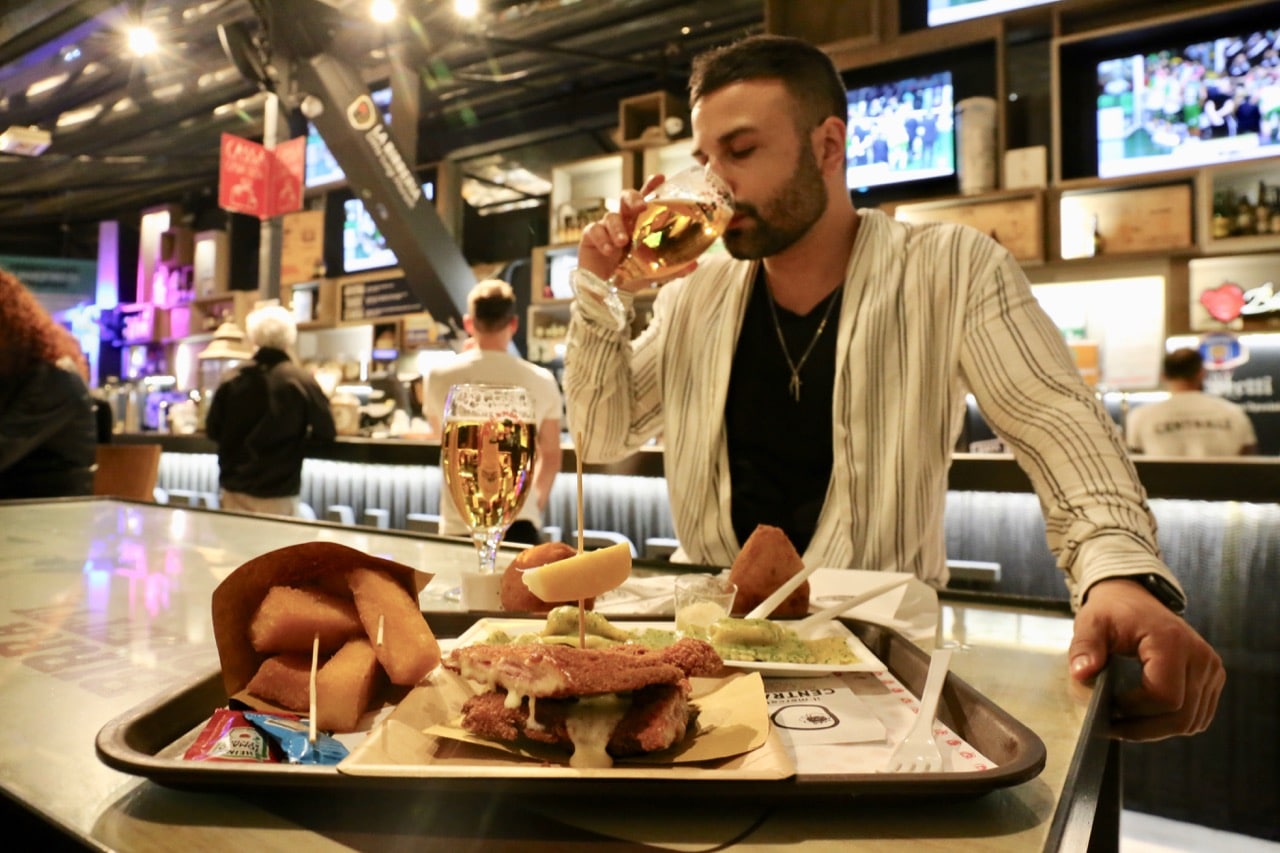
Finish Your Florence in a Day Itinerary at Mercato di San Lorenzo
A 13 minute walk from Ponte Santa Trinita.
There’s no better way to conclude a Florence in a day whirlwind adventure then by indulging in a truly Tuscan feast. We suggest ending your 24 hours in Florence at Mercato di San Lorenzo’s bustling food hall.
The San Lorenzo Market is actually comprised of two separate markets. The indoor market is known as Mercato Centrale and it’s where you’ll find all things food. The outdoor section lines the surrounding streets of the imposing Mercato Centrale building and features merchants selling leather goods, clothing and souvenirs.
The Central Market is a double decker food market, located in a beautiful building designed by Giuseppe Mengoni in 1874. Step inside and you’ll find an interior built of cast iron and glass featuring ten arches on each side.
On the ground floor you’ll find a grocers paradise featuring local Tuscan products sold by fishmongers, butchers and fruit and vegetable vendors. Our favourites spots to stop are the speciality shops that focus on premium products such as balsamic vinegar, olive oil, antipasti, cured meats and cheese.
Skip up to the buildings second floor and you’ll find Italy’s most drool-worthy food court. The 3000 square metre space features 500 seats and a plethora of speciality restaurant concepts. The market’s gourmet food court is open seven days a week from 10am to midnight.
If you’re traveling with a plus one we suggest strolling through the food court together to make a note of what you’d like to share together. Since the concept is self catering, we suggest splitting up to pay for your dishes and drinks and then meeting at a designated table to enjoy your Tuscan feast.
Highlights from Mercato Centrale’s food court include an Italian bread maker, arancini expert, Florentine pasta restaurant, deep fried bar snack shop, pizzeria, gelato and chocolate boutiques, Chianti wine booth, Italian craft beer bar and a Tuscan cooking school.
Review Our Travel Checklist When Planning Your Next Adventure!
Find the best flights on Skyscanner
Never travel without insurance! We suggest World Nomads comprehensive coverage as it includes over 250 adventure activities such as scuba diving, bungee jumping and surfing.
If you’re planning a road trip make sure to compare the best local car rental options.
Looking to book a tour or VIP experience on holiday? Book the best local tours on Viator.
Be sure to check your travel destinations electrical plug requirements in advance. If you travel often be sure to purchase a multi-region adaptor.
Whether you’re marching through a city or exploring a rugged rural landscape, it’s important to ensure you’re traveling with comfortable footwear. We suggest these comfortable walking shoes for urban adventures or these waterproof hiking boots when embarking on a hike holiday.
Capture your holiday on a quality camera. We suggest the pocket-sized Canon Powershot G7 or professional SLR we shoot with Canon EOS 6D.
Some of the links in this story use affiliate links. This means that if you book your accommodation through our site, Dobbernationloves will earn a small commission at no extra cost to you. Your support helps us to produce comprehensive content.
